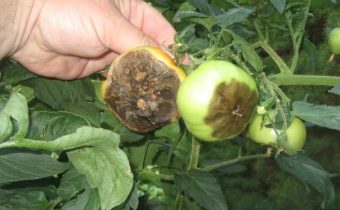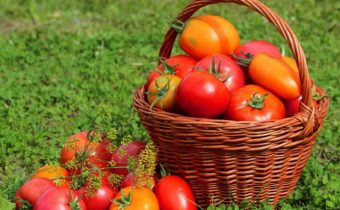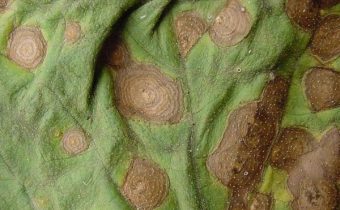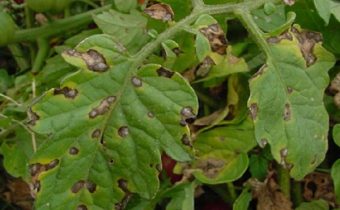Tomato stolbur: control measures, signs of disease
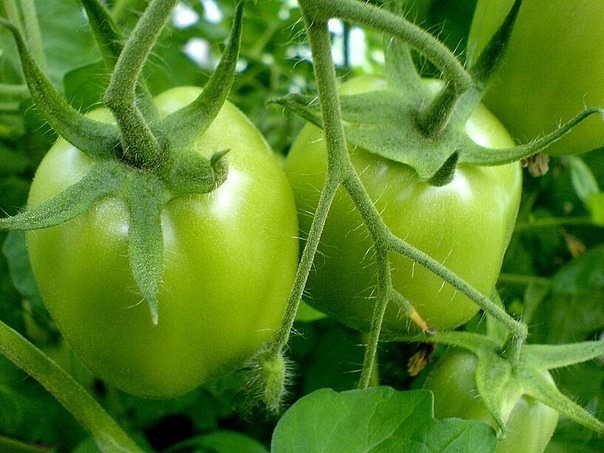
Stolbur - a dangerous disease that can destroy the harvest of tomatoes completely. The minimum possible damage is 30% of the fruit. The disease spreads quickly across the planting and is practically not treatable. Potatoes, eggplants, peppers, and grapes are also susceptible to stolbur.
Causes stolbur
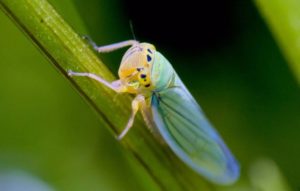
The disease causes the intracellular parasite Tomato stolbur phytoplasma. Carriers of the pathogen are insects. Infection of tomatoes most often occurs through a green tsikadku or Mlokosevich tsikadku, but the carriers of a harmful microorganism can also be bugblade and clover aphrodes. The pathogen spends winter in the roots of perennial weeds, from which insects are infected in spring and summer. Phytoplasm is not transmitted through seeds.
The timing of the destruction of tomatoes by stolbur depends on the periods of activity of the pests. The departure of tsikadok begins at the end of May, their population reaches the maximum number by mid-July. As a result, the disease usually manifests itself in the second half of August, but may develop as early as mid-summer (the incubation period after infection of the plant is 30 days).
Stolbur is more often seen in tomatoes growing on open ground, mainly in the southern regions, because dry and hot weather is necessary for the breeding of the tsadok.
If the tomatoes were infected at an early stage of development, the fruit on the bushes will not be tied. In the case of late defeat (at the stage of fruit loading), 70% of vegetables are usually edible, but all that started later will be inedible.
Symptoms of the disease
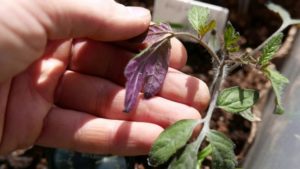
The parasite is introduced into the cell and intercellular fluid of plants, disrupting biochemical processes and causing abnormal growth of tissues. As a result, with stolbur's disease, the appearance of all the organs of the tomato bush changes.
Signs of stolbur in tomatoes:
- Leaves appear yellow with a pink or lilac shade, the edges are raised along the central vein. Young leaves do not grow to size.
- The flowers are deformed, they can have fused or reduced petals, be uncharacteristically large. Petals get a pale shade or greenish tones in color.
- The fruits of tomatoes take an irregular shape, the seeds are missing or contained in small quantities. The flesh permeates white and hard fibrous tissue - lignified, hypertrophied vessels. Infected fruits are not edible.
- On roots many cracks are formed, their skin gets a brown shade.
- Lignification of the internal tissues of the fruit, roots and stems of tomatoes occurs.
Possible treatment
Tomatoes that have become sick with a pillar need to be destroyed, because the plants cannot be harvested, but they will become a source of infection for others. Bushes need to dig with the roots and burn. The soil on which the diseased tomato grew should be replaced.
In a situation where the first symptoms of stolbur appear during the ripening of fruits, using antibiotics, you can delay the development of the disease in order to have time to harvest part of the crop. In this case, the tetracycline preparations are effective; a solution in a concentration of 0.5-1% is prepared for spraying. Antibiotic treatment should be carried out every 3-4 days.
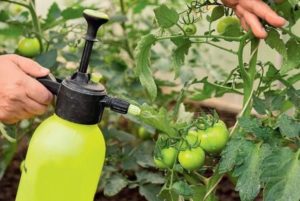
In addition, it is useful to give tomatoes foliar nutrition from trace elements to stimulate the processes of photosynthesis (magnesium, manganese, calcium, iron), disturbed by the activity of phytoplasma in the cells. This will give the plants an additional delay in growing the fruit. After the unaffected vegetables are harvested, the bushes must be eliminated, since the entire subsequent crop will already be infected.
The main measures to combat the disease associated with the prevention of its spread in the garden of tomatoes. It is recommended to spray healthy bushes with antibacterial agents. At the moment, the only drug effective against stolbur is Phytoplasmin. It is a biological tool that is safe for humans. Planting treatments are carried out twice with a break of 7-12 days, using a 0.1% solution of the agent. The stability of healthy plants at this point can be supported by irrigation with immunomodulatory drugs.
If the soil is irrigated with Phytoplasmin (as a preventive measure), 4 days after using the product, it should be irrigated with microbiological fertilizers (for example, Extrasol). Bactericidal preparations adversely affect the state of microflora in the soil, therefore, after their use, restoration measures are necessary.
Prevention
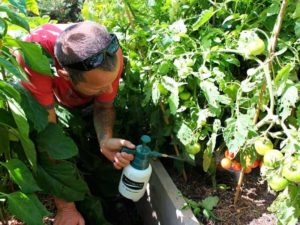
Due to the lack of effective drugs for the treatment of stolbur, in regions where conditions are favorable for the appearance of the disease, it is necessary to take all possible preventive measures.
Disease prevention involves:
- Tomato protection against waterfalls. It is necessary to spray tomato seedlings with insecticides on the eve of planting in open ground and a week after it. The drug Cirocco is recommended from tsikadok, Fufanon, Citkor, Fastak, Decis Profi, Confidor, Fury and Mospilan will also be effective.
- Planning landings. Mechanical method of dealing with a circus is planting around the perimeter of a tomato bed of tall crops (sunflower, corn, etc.). Plants make a kind of hedge that will prevent most insects from getting to the tomatoes. It is desirable that the tomatoes and other solanaceae, prone to stolbury, grow at a maximum distance from each other (ideally a distance of 500-1000 m).
- Weed control. First of all, it is necessary to remove spurge, chicory, field bindweed, dope, nightshade, plantain, sow thistle from the site and adjacent territories. On these herbs the stolbur pathogen parasitizes.
- Prophylactic treatments. Despite the fact that effective drugs for the treatment of stolbur does not exist, you can significantly reduce the risk of injury with the help of the “Farmod” drug. Spraying should be started during the peak of the activity of the tsikadok and spend at least a month every 1-1.5 weeks. Tentative terms - from June 15 to July 15.
- Watering bactericide. Produced at the beginning of the departure of tsikadok (end of May), using a 0.2-0.3% solution of "Fitoplasmin" (0.5 liters under each bush). Make a tool in the ground can be 1 time per season.
- Early landing. Taking into account the time of departure of the tsikadok and the incubation period of phytoplasm, it is possible to avoid infection of tomatoes with stolbur, preferring early-ripening varieties.
- Fertilization. Proper feeding of tomatoes can shorten the ripening of fruits, thereby reducing the likelihood of infection with their stolbur.
- Selection of seed. Tomatoes grown from healthy, viable seeds have higher resistance to diseases and endurance to adverse conditions. The smallest resistance to stolbur is shown by the seeds of tomatoes affected by aspermia. But pre-sowing treatment of seed, contrary to popular belief, is ineffective as a stolbur prevention (but effective in the case of other diseases), because the pathogen is not transmitted through the seed.
Tomato-resistant varieties of tomatoes are quite small and a 100% guarantee that infection will not occur, breeders do not give. But it is possible to significantly reduce the risk of the disease if you plant on the site tomatoes such varieties as:
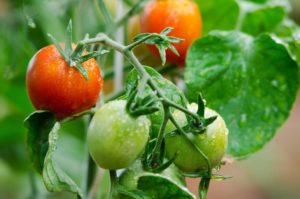
- Volgograd 5/95;
- "East";
- Shtambovy Alpatyev;
- "Sir F1";
- Premium F1;
- "Elizabeth F1";
- "Legionnaire F1".
Tolerant to stolbur, i.e., to a lesser extent than ordinary varieties, prone to disease, are hybrids Tribeca F1 and Phenomena F1.
According to the research of the All-Russian Research Institute of Irrigated Vegetable and Melon-Growing (Astrakhan) based on materials collected over 40 years, most varieties that are not exposed to tobacco mosaic virus have resistance to stolbur.
As such, there is no way of dealing with stolbur. The disease appears foci and disappears if in subsequent seasons there are no suitable conditions for its development. But a single occurrence of the disease causes great damage, because, as a rule, spoils a significant part of the crop. Horticulturists from regions where the probability of stolbur is high should be made preventive by the usual measures for caring for tomatoes. Residents of regions located north of the Samara region are advised to turn to prevention only in particularly dry and hot years.


